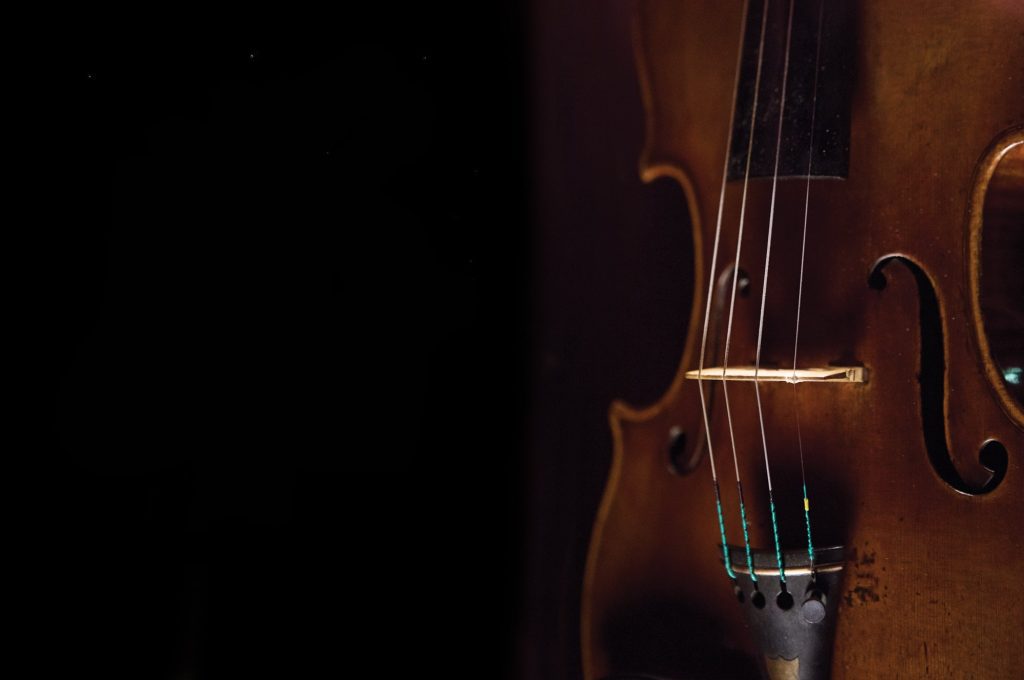Antonio De Lorenzi takes a seat onstage in the concert hall of Museo del Violino in Cremona, Italy, and carefully tucks a Stradivarius under his chin. The violin, crafted in 1727 and called Vesuvio, gleams red in the soft light of the auditorium. Through an earpiece, the soloist hears a metronomic beat as a voice says, “Go.”
De Lorenzi draws his bow across the lowest string and plays G for half a beat. He pauses, then follows with A-flat. Then A. He moves up the scale, never changing his pace as he works through all four strings. Once he finishes, he repeats the exercise, this time sounding each tone just a bit faster.
Clearly, this is no ordinary concert—or a typical practice. Outside, police have cordoned off the street to traffic. Inside, workers have shut down the heater despite the January chill, dimmed the lights, and unscrewed any buzzing bulbs. As each solitary note reverberates, an audience of 32 microphones dotted throughout the auditorium silently listens.
De Lorenzi’s performance is part of a campaign to preserve the Stradivarius sound. Although many of the approximately 1,100 stringed masterpieces that Antonio Stradivari and his sons handcrafted in this town have endured for some 300 years, they are still mortal. Almost half have been lost to accidents, haphazard repairs, or the wear that comes with age. Of the 650 or so that survive, some have grown too fragile to play, their wood too thin or joints too weak to take the string tension or bowing pressure. Even those that still see regular use may change over the decades, as time and vibration slowly alter their mellifluous tone.
Stradivari remains the defining figure in violin-making, a name on par with Chanel or Ferrari. He fashioned instruments for kings and cardinals, and his creations bring their distinctive voice to the repertoires of modern soloists like Itzhak Perlman and Anne-Sophie Mutter. Musicians, luthiers, and scientists have tried for decades to figure out what gives a Strad its beautiful sound, yet no one has ever quite replicated it. And so the dream is to create a digital archive that will survive long after the last Stradivarius falls silent, allowing composers and artists to continue making music with them.
De Lorenzi proceeds, working through scales at varying tempos, intensities, and volumes with the precision and passion he’d bring to a Dvořák symphony or Verdi opera. In a stuffy, soundproofed room tucked beneath the auditorium’s seats, audio engineer Thomas Koritke, whose company will create a virtual version of the instrument, listens through speakers as his computer records it all. He will do this every day for five weeks, meticulously documenting thousands of variations of the sounds Vesuvio and three other masterworks of its era can produce.
The museum hopes this painstaking exercise grants the rare treasures a degree of immortality so they might enchant future generations. “These instruments have been played for 300 years,” says Fausto Cacciatori, a curator there. “We are committed to making them play for another 300.”
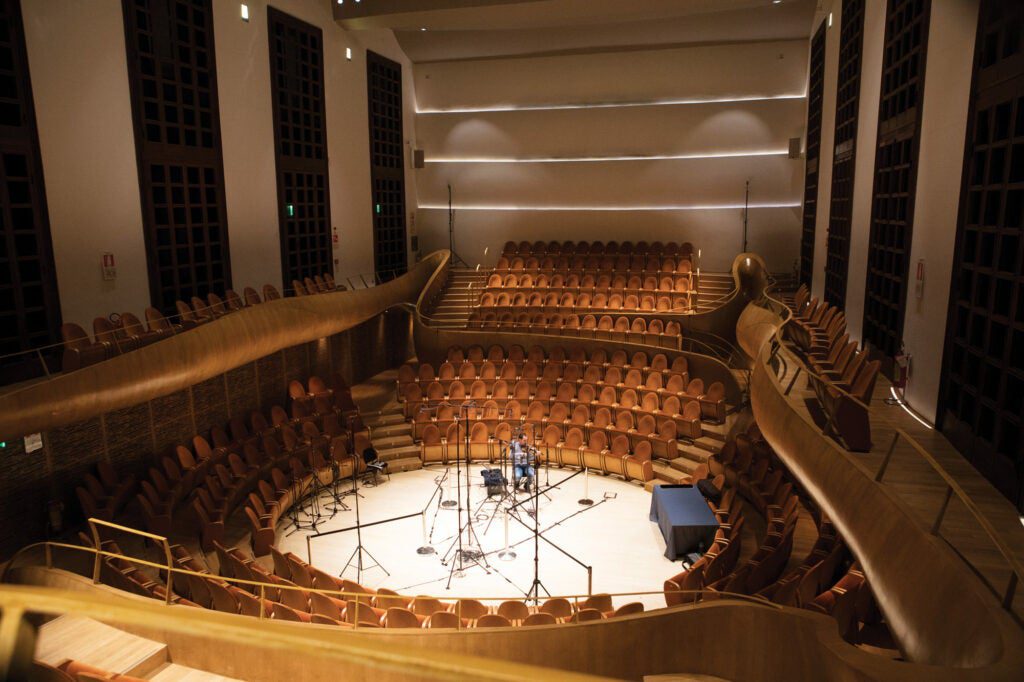
The Museo del Violino, which opened in 2013 to celebrate the work of Stradivari and others, sits in the heart of Cremona. The ancient city, about an hour outside Milan, began as a Roman colony in 218 B.C. and developed a rich, cosmopolitan culture under Spanish, French, Austrian, and Italian rule. By the 17th century, the town was home to a thriving community of instrument-makers. (Even now it boasts some 250 luthiers.)
Historians credit craftsman Andrea Amati with creating the modern violin here in the 1500s. But it was Stradivari, born around 1644, who combined three key innovations that helped accelerate the instrument’s transition from the chamber rooms of the Baroque period to the concert halls of the Classical: He designed his offerings slightly larger than his contemporaries. He flattened the arch of the top plate, called the belly, and made the piece lighter than was customary. He elongated the f-shaped holes that permit the belly to vibrate freely and allow the air resonating inside to more easily radiate as music. These changes provided the powerful sound and projection musicians sought. “He perfectly understood the new requirements of the violinists of the time,” Cacciatori says.
At base, the material used to craft any stringed instrument determines its sound. Violin-makers have, since Amati’s time, considered spruce ideal for the belly; its grain has the strength to endure the tension of taut strings, yet provides enough flexibility to vibrate freely. The best of it comes from Alpine regions, where cold weather slows tree growth, creating the tight grain that maximizes resonance. “If you choose a very good piece of wood and understand how to work with it, you’ll have a very good violin,” says Massimo Lucchi, co-founder of the Academia Cremonensis, a violin- and bow-making school in Cremona. Luthiers favor maple for the body and neck for its ideal mix of strength, resonance, and aesthetics.
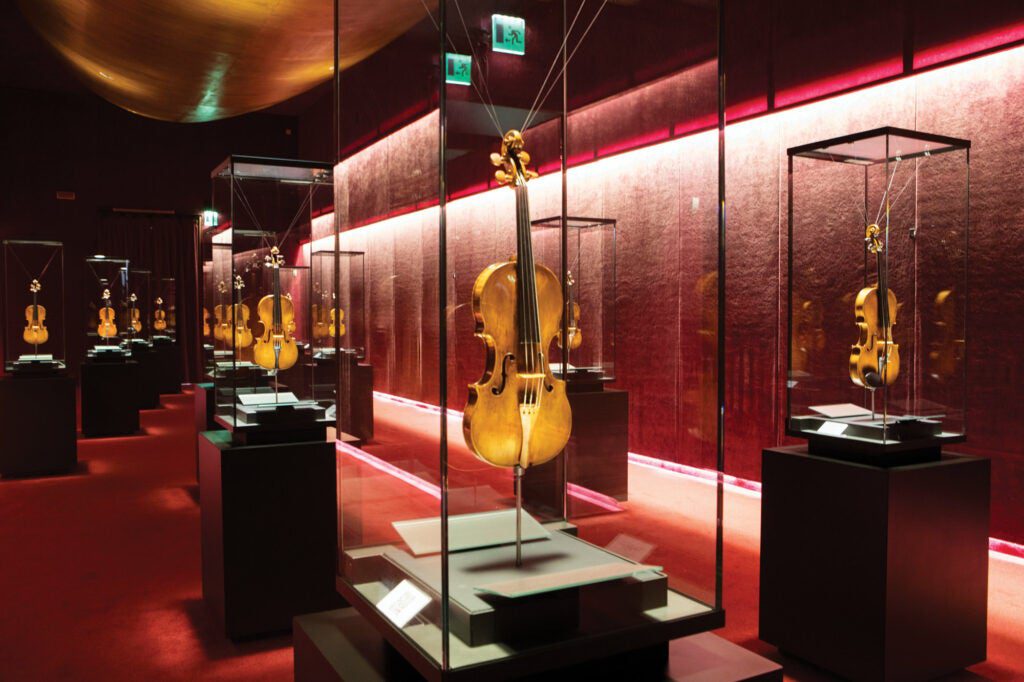
Given the importance of wood, it’s natural that any effort to understand what gives a Stradivarius its storied voice would begin there. In 2003, researchers suggested that the lumber Stradivari sourced from forests in the Val di Fiemme in northern Italy’s Dolomite Alps was the beneficiary of an unusual cool period in history. For 70 years, beginning in 1645, average temperatures dropped as much as 1.8 degrees Fahrenheit throughout Europe and North America. Trees grew slowly during this time, called the Maunder Minimum, resulting in denser structure with tighter grain that, the thinking goes, made Stradivari’s instruments more resonant. A radiologist at Leiden University Medical Center in the Netherlands bolstered that theory in 2008, when his CT scans of two Stradivari creations, three by his peer Giuseppe Guarneri, and eight modern ones revealed that the old masters’ handiwork featured slightly more-even grain. Skeptics like retired biochemist Joseph Nagyvary of Texas A&M University discount the idea, however, arguing that luthiers throughout the continent relied upon the same forest, yet their results do not rival the Strad tone.
Nagyvary, who also builds violins, has spent four decades seeking Stradivari’s secrets. He has used tools like electron micrographs and infrared spectroscopy to argue that a variety of substances altered the structure of the craftsman’s spruce and maple. He believes Cremonese luthiers used borate and salts of copper, iron, and chromium to prevent woodworm infestations, and that some of these materials bonded with polysaccharides in the wood, stiffening it and improving its resonance. He also suspects that Stradivari took the added step of smoking the timber in his chimney. Beyond killing pests, the practice would have reduced moisture, giving his instruments superior tone. “You cannot have a Stradivari sound unless your wood is preserved and restructured by chemical manipulations,” Nagyvary says.
Researchers led by Hwan-Ching Tai, a chemist at National Taiwan University, bolstered that idea in a paper published in 2017. His team tested maple shavings taken from several Stradivari instruments during repairs. Ionizing them with plasma and analyzing the atoms released by that process revealed traces of many elements that Nagyvary claims the master used to treat his wood.
Chemists have also scrutinized the red varnish that Stradivari started using in the 1690s. Researchers have claimed that the coating, made with the cochineal beetles of Mexico, contained everything from eggs and animal protein to myrrh and amber. But an analysis of five Stradivarius creations by French chemist Jean-Philippe Échard found nothing more than finishes widely available to luthiers at the time.
All of this speculation stems from the fact that Stradivari didn’t share his methods. He left no notes, no diaries, nothing to reveal how he built his instruments or what gave them their tone. Science can provide clues, but few believe we’ll ever solve the mystery. We are left only with the sound.
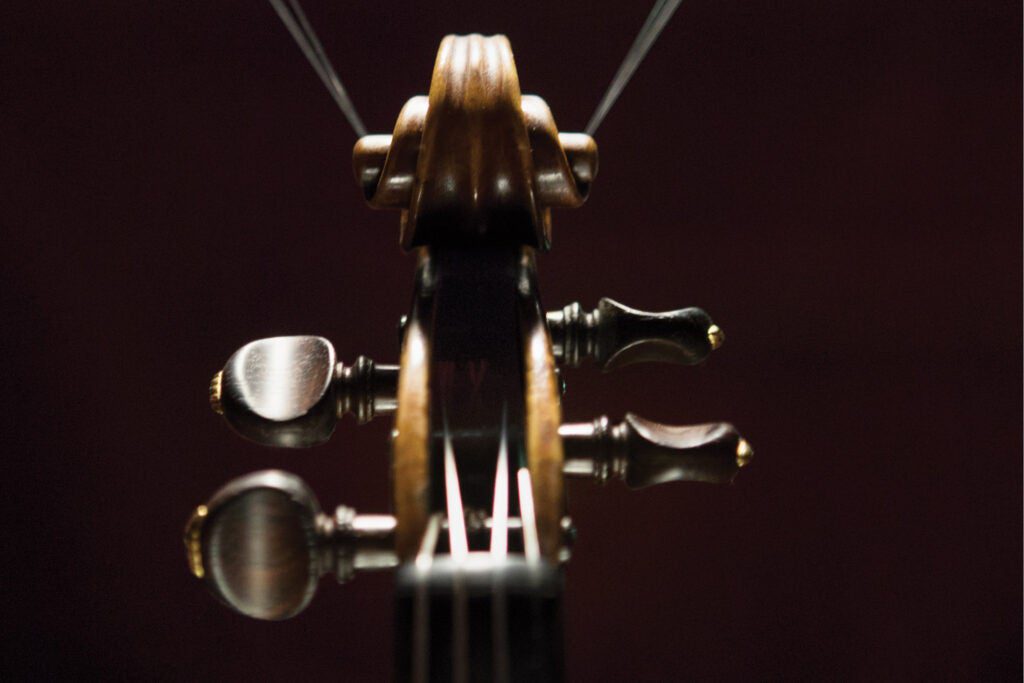
One night in February 2019, Koritke was sitting in his small control room when he heard an odd noise. It took a moment to realize what it was: the soft snoring of the armed guard who always accompanied the prized instruments. A kind word from the musician gently woke the fellow. “We all had a good laugh,” Koritke says.
The idea for Koritke’s endeavor, dubbed the Stradivarius Sound Bank, started about five years ago with sound engineer Leonardo Tedeschi. The former DJ was working on a project using a software program from Koritke’s company e-Instruments that replicates an 11-piece string ensemble. Tedeschi found it so impressive that he wanted to create a similar tool for Stradivarius violins, which he was surprised to learn no one had ever sampled in detail. He pitched the idea to Koritke. As a fan of acoustic music, Koritke immediately saw an opportunity to preserve an irreplaceable masterpiece.
The museum’s auditorium was an ideal venue. Its designer had tuned the shape and dimensions to perfectly reverberate the sound of stringed instruments. “When I saw the concert hall, I thought, This is something really extraordinary,” Koritke recalls. Yet he worried about ambient noise, and proceeded only after city officials promised to mitigate the interference.
Koritke planned to record a lone Stradivarius violin, but after discussing the project with museum staff, chose a string quartet. In addition to Vesuvio, the combo included a Guarneri violin named Prince Doria, the Amati viola known as Stauffer, and a Stradivari cello also called Stauffer.
His team spent three years planning the undertaking, mapping out the thousands of articulations required to create a database of every sound those instruments can produce. “It was all written out as music on sheet paper,” Koritke says. “This is quite a challenge. Most of the musicians had never done that kind of an exercise.”
Koritke’s crew spent a day setting up all the recording equipment and another three arranging the array of microphones. “It became quite difficult because there were so many in quite a small area,” he says. During each phase, the musicians would run through scales and arpeggios at varying volumes and tempos, performing dozens of intonations of every note. They repeated these routines for hours at a time, using different bowing techniques or by plucking the strings, playing thousands of transitions with exacting precision. “Sometimes the musicians would stop at a certain note because they weren’t happy, but we thought it was OK,” Koritke says. “They would say, ‘No, I don’t like this part; let’s do it again.’”
Outside noise frequently disrupted the process. Although the city closed two streets near the concert hall and a nearby parking lot, bicycle tires rolling on cobblestones, barking dogs, and clinking glasses in the museum cafe all interrupted the sessions. That prompted the mayor to urge the city’s 70,000 residents to keep quiet in the area, though there wasn’t much anyone could do about the peal of church bells or the drone of airplanes occasionally passing overhead.
In the end, Koritke captured 1 million individual audio files, totaling 8 terabytes. His team will cull the trove to create virtual versions of the instruments that anyone can add to off-the-shelf recording programs like Pro Tools. That means choosing the most musical and precise instance of every tone, a process he expects will take until early 2020. “You must listen to all of them and decide how they match,” Koritke says. “How does the G match to the G-sharp, the C match to the C-sharp, and so on.”
Tedeschi is eager to see what musicians create with the digitized string quartet. He sees the software, which should be available for purchase by mid-2020, introducing the instruments to new audiences through entirely new styles: “Maybe Skrillex will do crazy stuff with a Stradivarius violin,” he says. “You can use it in a lot of genres.”
The question is, will anyone realize it’s a Strad?
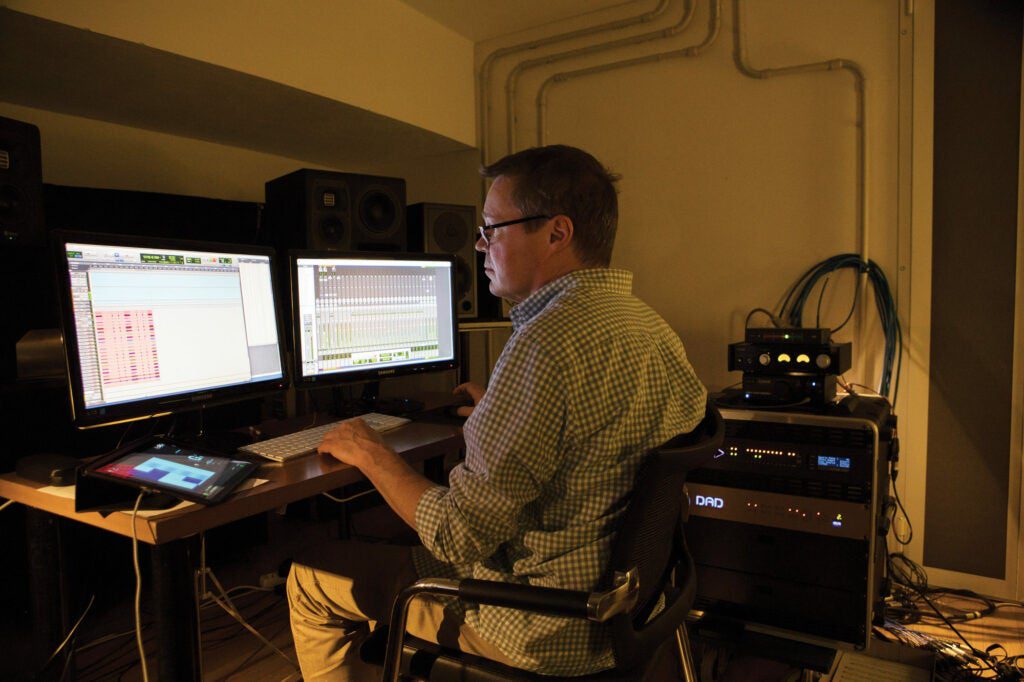
The premise of the Stradivarius Sound Bank rests on the idea that nothing sings as finely as the original. Joseph Curtin isn’t sure that’s true. He took up the violin at age 10 and started making them about a decade later, in 1978. Like many luthiers, he developed an abiding fascination with Stradivari and his peers, and hoped to replicate the renowned tone of their masterpieces. In time, Curtin began pondering theories to explain their superiority until a physicist friend suggested he first prove that Strads truly do eclipse all others. “That’s when I realized there was no scientific evidence suggesting the old Italian instruments sounded better than modern ones,” he says.
That prompted Curtin and Claudia Fritz, who studies psychoacoustics at the Sorbonne in Paris, to conduct a double-blind study. In 2010, 21 soloists meeting in Indianapolis for an international competition donned dark welding goggles, and each played two Stradivariuses, a Guarneri, and three modern violins. Thirteen of them preferred new instruments, and seven liked one of the Strads least of all.
The two researchers drew criticism for their methods, which included holding the test in a hotel room. So the pair ran a more rigorous study in Paris in 2012 involving six violins crafted by Italian masters (five of them Strads) and six by present-day luthiers. They used new instruments that were weathered to appear old, and the 10 professional soloists once again wore goggles. Each used their own bow while playing during 75-minute sessions in a rehearsal space and a small concert hall. Six preferred the sound of the modern models. On average, the musicians favored the playability, articulation, and projection of contemporary violins, and none could identify the Strads with better than coin-toss accuracy. “We have yet to find that players can discern old from new,” Curtin says.
That, of course, does not diminish the quality of Stradivari’s masterpieces, or his contributions to the art of making violins. “I don’t have one whit less reverence for his work,” Curtin says. “I am challenging the assumption that they are necessarily better-sounding than modern instruments.”
All of this might be beside the point. Strad’s unique voice and historical importance alone make them worthy of preservation. Around the world, institutions and archivists conserve paintings, sculptures, and documents like the Magna Carta and US Constitution. Those behind the recording project say sound deserves similar consideration. “When you look at museums all over the world, digitizing their content is standard,” Koritke says. “Why not do that for instruments? It is a bit of a departure from traditional thinking to preserve the sound of something. This could open the door to that.”
He envisions museums allowing patrons to use a tool like the Stradivarius Sound Bank to hear what these masterpieces sound like. He believes that the pipe organs of Europe’s great cathedrals are likewise worthy of saving. You could make a case for digitizing icons like, say, Trigger, Willie Nelson’s battered acoustic guitar. Tedeschi favors recording the offbeat, even outlandish, musical creations of avant-garde musicians like Björk or Martin Molin. “There are,” Koritke says, “so many other famous instruments in the world that would benefit from being digitized.”
This story originally published in the Noise, Winter 2019 issue of Popular Science.





